...
Kinderfachabteilung Ansbach
Home
Ansbach (Mittelfränkische Landes-, Heil- und Pflegeanstalt Ansbach)
*For more information, see Lutz Kaelber and Mark-Kevin Deavin, Einzelnen
Kindern im moribunden Zustand medikamentoese Sterbehilfe geleistet: Dr.
Irene Asam-Bruckmüller, in Täter-Helfer-Trittbrettfahrer. Vol. 15:
NS-Belastete aus Mittelfranken, edited by Wolfgang Proske
(Gerstetten: Kugelberg Verlag, 2023), pp. 295-307. Further research will
be published in Lutz Kaelber, "Kinderfachabteilung Ansbach" in Dr.
Patricia Heberer, ed. Nazi Sites for Racial Persecution, Detention,
Murder, and Resettlement of Non-Jews, the forthcoming fifth volume of the
US Holocaust Memorial Museum's Encyclopedia of Camps and Ghettos,
1933-1945.
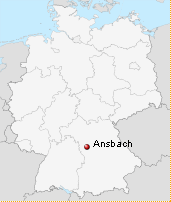
The Kinderfachabteilung in Ansbach existed between late 1942 (as the last
one of three in Bavaria) and March 1945. Its medical director was Dr. Hubert
Schuch, and the physician responsible for the special children's ward were
Dr. Irene Asam-Bruckmueller (she died in 2000), assisted by Dr. Priessmann
(he committed suicide after WWII). The first victim, Elisabeth M., was
admitted on Dec. 1, 1942, which points to the possibility that the ward was
established slightly earlier than suggested in previous research.
Of 303 children admitted to the "special
children's ward," 156 died. 144 extant medical records of the dead
children indicate a range in age from one week to 16 years. In at least 86
cases the brains of the children were sent to the pathology dept. in
Eglfing-Haar (itself a site of a children's ward) and (mostly from there,
but also directly) to German Research Institute for Psychiatry
(Kaiser-Wilhelm institute) in Munich for neuropathological research.
889 of Ansbach's patients were transferred to T4
gas murder facilities in 1940 and 1941, for which it also operated as a
transit facility. In 1941, the introduction of an early version of
the 1942 Bavarian starvation diet decree (Hungerkosterlass) was associated
increasing numbers of deaths at the facility, which totaled over 1,200
between 1939 and the end of 1944. The implementation of the Nazi
compulsory eugenic sterilization law led to the sterilization of 379
patients.
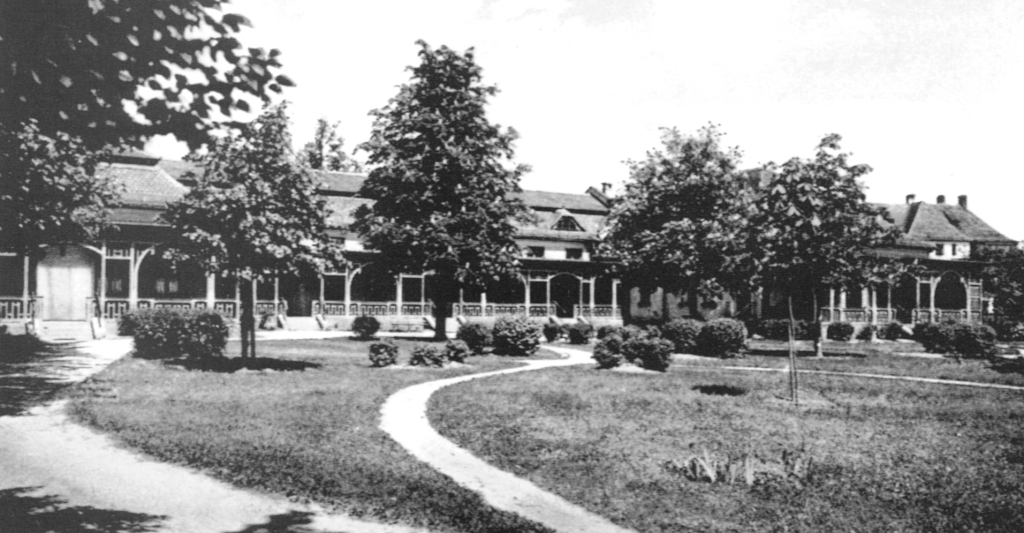 Source: Fitz, p. 137.
Source: Fitz, p. 137.
The location of the "special children's ward" was house 15, which was torn
down and replaced by a modern building in 1965.
Dr. Asam-Bruckmueller was briefly interrogated by American authorities in
Nuremberg in 1946, and the state attorney's office in Munich
investigated Dr. Schuch in 1947-48. Both physicians were witnesses in
the criminal investigations of Hans Hefelmann in 1961. In the mid 1960s
state prosecutors began investigating Dr. Schuch, Dr. Asam-Bruckmueller, and
a head nurse. This investigation did not lead to a criminal convictions
in court as both individuals were not considered capable of standing trial.
In February 1946, Dr. Leusser, the director the clinic, had described the
"euthanasia" killing of children during National Socialism as follows:
In the years 1943 and 1944 a number of
children, who stood at the bottom of the scale of idiocy and for the most
part displayed severe physical deformities and who could be expected to perish sooner or later through
bedsores or pneumonia, were killed by putting [them] to sleep with
luminal. [quoted in Hohendorf 2007-2008, pp. 33-34]
In the late 1980s, important developments occurred at the clinic that led to
the first publication on the subject and the display of two
plaques. Dr. Reiner Weisenseel wrote his dissertation under Dr.
Athen, then the director of the Ansbacher Bezirkskrankenhaus, on the
involvement of the clinic in Euthanasia crimes, including the operation of
the Kinderfachabteilung. In 1988 two members of the Green Party as well as
the regional diet (Bezirkstag) were horrified to find portraits
of physicians involved in Nazi euthanasia crimes among the honorary
display of medical personnel in the administrative building, and they
successfully petitioned to have these portraits removed.
Since 1992 a plaque hangs in the entry hall way of the administrative
building. It reads: "In the Third Reich the Ansbach facility delivered to
their death more than 2000 of the patients entrusted to it as life unworthy
of living: They were transferred to killing facilities or starved to death.
In their own way many people incurred responsibility." It continues: "Half a
century later full of shame we commemorate the victims and call to
remember the Fifth Commandment." The active killing of children specifically transferred to the clinic to be
murdered is not noted. The plaque does not address that
that euthanasia victims were not only starved or transported to
gassing facilities but actively killed with barbiturates on site.
 Author's picture
Author's picture
At around the same time (in 1990) a historian, Diana Fitz, was
commissioned by the Ansbach town council to provide a detailed study of
"Ansbach under the swastika." The study was published in 1994 and was much
more widely and easily available than Dr. Weisenseel's dissertation in 1990.
Dr. Fitz's study includes a chapter on the Heil- und Pflegeanstalt, with
sections on "children's euthanasia" and prosecutorial dealings with the
perpetrators after WWII.
There is a permanent exhibit on psychiatry
(Psychiatrie-Dauerausstellung) on the premises in Haus 10 (see here). It was established on occasion of the
celebration of the 100th anniversary of the clinic in 2002. It has
approximately 200-250 visitors annually, but it is only accessible in the
company of the museum director and typically to groups
(as well as during the annual open house; "see here). Apart
from presenting a series of artifacts from past psychiatric practice,
including various medical instruments and an authentically preserved padded
room, one room has several displays that inform about the clinic's
involvement in medical crimes during WWII. Based on Dr. Weisenseel's
investigations, two displays address the clinic's role in the "children's
euthanasia program" and the outcome of the criminal investigations.
Author's pictures
Source: Museum
Most recently, the memorialization of victims has commenced on the Day
of the Dead (Totensonntag), on which the first names of the youngest victims
are read aloud. A detailed flyer on an expanded web site about the history of the facility informs
visitors about the site and the Nazi crimes (see here).
In 2010, the exhibit "In memoriam" (by Dr. v. Cranach) was shown in Ansbach.
Panels on the Ansbach facility and its involvement in Nazi medical
malfeasance, including one about the special children's ward, by Daniel
Goltz were included (see here).
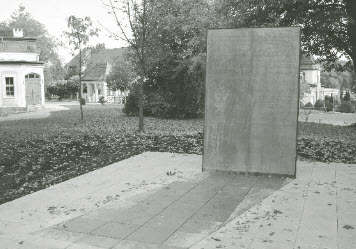 Source:
http://www.bezirksklinikum-ansbach.de/fileadmin/user_upload/pdf_Dateien/121125_Einweihung_Mahnmal.pdf
Source:
http://www.bezirksklinikum-ansbach.de/fileadmin/user_upload/pdf_Dateien/121125_Einweihung_Mahnmal.pdf
A new memorial was put in place in 2012. It consists of a steel plate on a
square platform. The plate tilts backwards, meant to reflect the seriousness
of the crime (or its legacy). It can also cast a large shadow (indicative of
how this part of Ansbach's past has been dealt with, or not, and how it is
still relevant today). Engraved in the plate are 2,000 lines, reflective of
the banality of evil (the bureaucratic approach to killing). The lines are
individually set, to portray that the individuality of each of the 2,000
victims and his or her fate.
In 2013, a puppet show on Friedrich Zawrel (see Kinderfachabteilung
Spiegelgrund) was shown in town (see here).
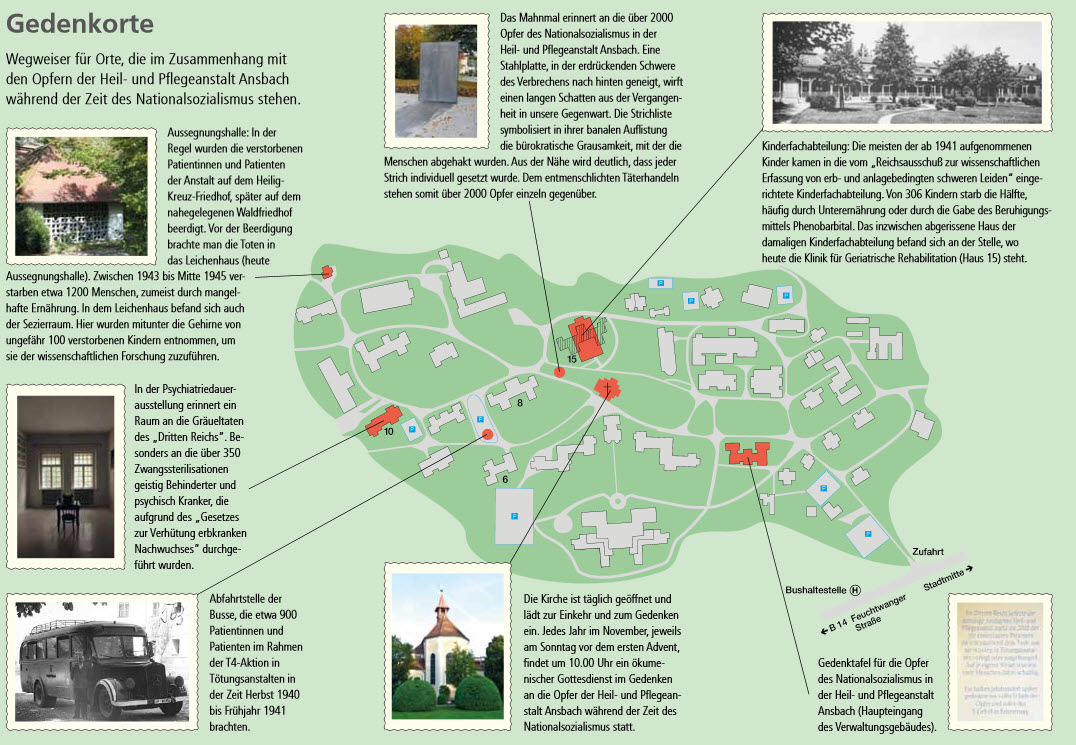
Source:
http://www.bezirksklinikum-ansbach.de/fileadmin/user_upload/pdf_Dateien/Flyer-61_Gedenkorte-AN_2012.pdf
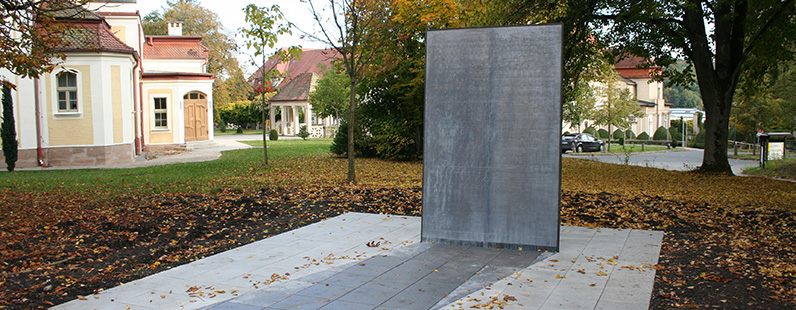
Source:
http://www.bezirkskliniken-mfr.de/fileadmin/user_upload/Bilder/Unternehmen/Geschichte/AN-geschichte6_banner.jpg
The current website of the clinic addresses the clinic's
past succinctly, including the "Kinderfachabteilung" (here).
Several exhibits since 2010 have been shown in Ansbach (1; 2).
Literature
Benzenhoefer, Udo. 2003. "Genese
und
Struktur der 'NS-Kinder- und Jugendlicheneuthanasie.'" Monatsschrift
fuerr Kinderheilkunde 151: 1012-19.
-------. 2020.
Kindereuthanasie in der NS-Zeit unter besonderer Beruecksichtigung von
Reichsausschussverfahren und Kinderfachabteilungen (Ulm: Klemm &
Oelschlaeger, 2020)
Bussiek, Dagmar. Albert
Viethen. Direktor der Universitaetskinderklinik 1939-1945, in 100 Jahre
Kinderklinik Erlangen, edited by Wolfgang Rascher and Renate
Wittern-Sterzel (Goettingen: V&R unipress, 2005), pp. 125-211
Fitz, Diana. 1994. Ansbach
unter dem Hakenkreuz. Ansbach: Stadt Ansbach.
Hohendorf, Gerrit. 2007-2008. "The Representation of
Nazi 'Euthanasia' in German Psychiatry 1945 to 1998: A Preliminary
Survey." Korot 19: 29-48.
Kinzelbach, Annemarie; Stephanie Neuner; Gerrit
Hohendorf; Maximilian Buschmann; and Philipp Rauh, Zwischen
Routinebetrieb, Erbgesundheitspolitik und NS-Krankenmord: Die Prosektur
der Deutschen Forschungsanstalt fuer Psychiatrie (1926-1962), Medizinhistorisches
Journal 57, 4 (2022), pp. 332-62
Laass, Francoise. 2008. "Ein Blick zurueck: Psychiatriedauerausstellung in Ansbach." KOM: Die Mitarbeiterzeitung [der
Bezirkskliniken Mittelfranken] 11, 4: 14.
Nedoschill, Jan and Rolf Castell. 2001.
"'Kindereuthanasie' waehrend der nationalsozialistischen Diktatur: Die
'Kinderfachabteilung' Ansbach in Mittelfranken." Praxis
der Kinderpsychologie und Kinderpsychiatrie 50:192-210.
Puvogel, Ulrike, and Martin Stankowski. 1996. Gedenkstaetten
fuer die Opfer des Nationalsozialismus, vol. 1. 2d ed. Bonn:
Bundeszentrale f. politische Bildung. Available at http://www.bpb.de/files/5JOYKJ.pdf.
Steger, Florian. 2006. "Neuropathological Research at the 'Deutsche
Forschungsanstalt fuer Psychiatrie' (German Institute for Psychiatric
Research) in Munich (Kaiser-Wilhelm-Institute): Scientific Utilization of
Children's Organs from the 'Kinderfachabteilungen' (Children's Special
Departments) at Bavarian State Hospitals." Journal
of the History of the Neurosciences 15:173-185.
Topp, Sascha. 2004. Der Reichsausschuss zur
wissenschaftlichen Erfassung erb- und anlagebedingter schwerer Leiden: Zur
Organisation der Ermordung minderjaehriger Kranker im Nationalsozialismus
1939-1945. Pp. 17-54 in Kinder in der NS-Psychiatrie,
edited by Thomas Beddies and Kristina Huebener. Berlin-Brandenburg: Be.bra
Wissenschaft.
---. 2005. "Der 'Reichsausschuss zur wissenschaftlichen
Erfassung erb- und anlagebedingter schwerer Leiden': Die Ermordung
minderjaehriger Kranker im Nationalsozialismus 1939-1945." Master's Thesis
in History, University of Berlin..
Weisenseel, Reiner. 1990.
"'Euthanasie' im NS-Staat: Die Beteiligung der Heil- und Pflegeanstalt
Ansbach an den 'Euthanasiemassnahmen' des NS-Staates." M.D. Diss., Medical
College, Friedrich-Alexander-Universitaet Erlangen-Nuernberg.
---. 1999. "Heil- und Pflegeanstalt Ansbach." Pp.
143-57 in Psychiatrie im
Nationalsozialismus: Die Bayerischen Heil- und Pflegeanstalten zwischen
1933 und 1945, edited by M. von Cranach and H.-L. Siemen. Munich:
R. Oldenbourg Verlag.
Zeidman, Lawrence. 2020. Brain Science under the
Swastika: Ethical Violations, Resistance, and Victimization of
Neuroscientists in Nazi Europe (Oxford: Oxford University Press.
Last updated August 2023


 Source: Fitz, p. 137.
Source: Fitz, p. 137. Author's picture
Author's picture
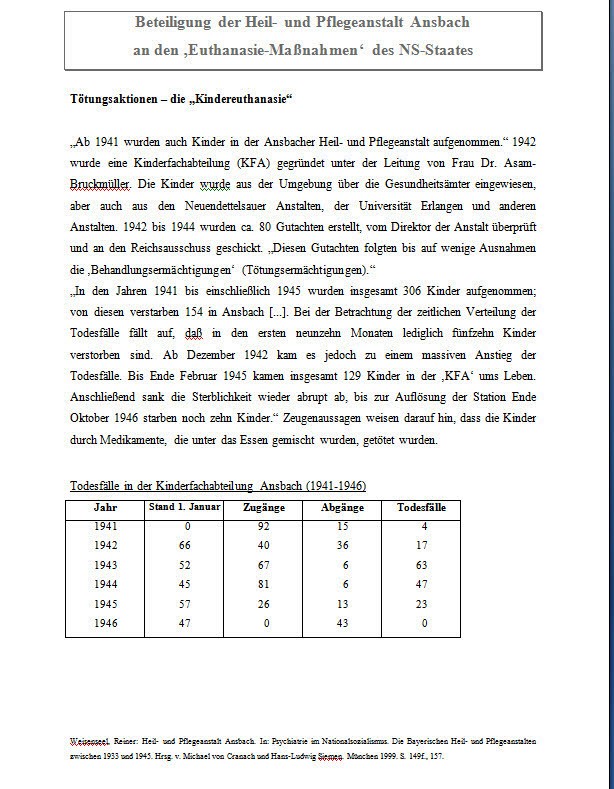
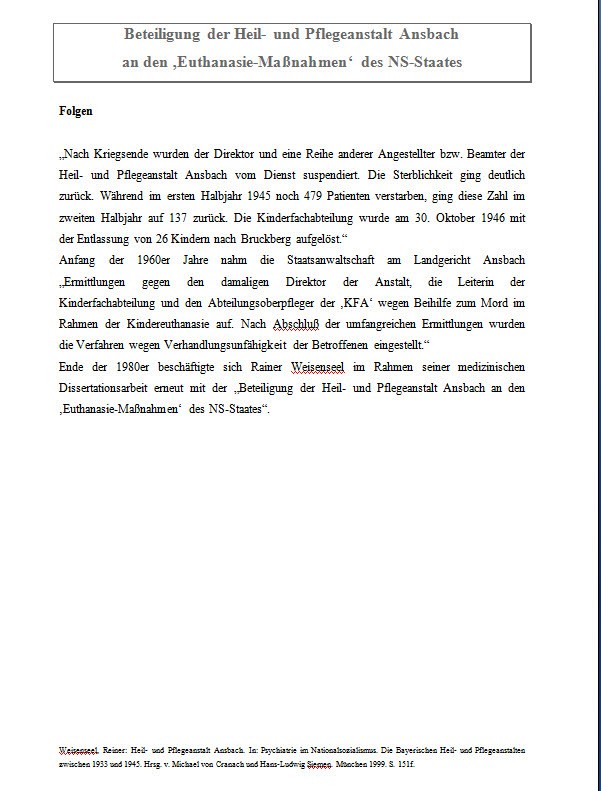
 Source:
http://www.bezirksklinikum-ansbach.de/fileadmin/user_upload/pdf_Dateien/121125_Einweihung_Mahnmal.pdf
Source:
http://www.bezirksklinikum-ansbach.de/fileadmin/user_upload/pdf_Dateien/121125_Einweihung_Mahnmal.pdf
